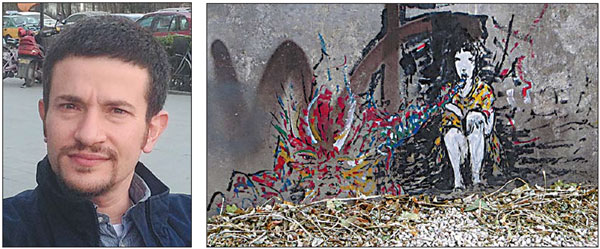Beauty in the capital's streets
Updated: 2015-03-27 07:31
By Chen Yingqun(China Daily Europe)
|
|||||||||||
An Italian business consultant exhibits his photographs of graffiti taken in Beijing
Mattia Bellomi's day job in Beijing is to help Italian companies understand the Chinese market, but he also is passionate about showing people around the world something else about China: its graffiti culture.
"People think about China only as a big market, big economy, but not so much about everyday, contemporary life, street life, what is going on, and so many things that are very much a part of people's lives," says the 40-year-old business consultant.
|
Italian business consultant Mattia Bellomi and one of the photographs he took of graffiti in Beijing. Photos provided to China Daily |
Bellomi is now putting on an exhibit called A Walk in Town, which includes 21 photographs he took of graffiti in the Chinese capital in the past year. The exhibit, which opened on March 7 at the Art Depot at the 798 art district in Beijing, will be shown in many other places in the next few months (a closing date has yet to be determined). He also is planning this year to take it to Europe, including Italy, Latvia and Belgium.
Bellomi says that while living in Chongqing in southwestern China, his interest was piqued when he visited the work of students of the Sichuan Fine Arts Institute, who covered an old tank factory with graffiti while turning it into an art workshop. He lived in Chongqing for about six years before moving to Beijing two years ago.
"Graffiti is open source, public, immediate, colorful, individual, not framed, just there for people to see it. It gives us real feelings," he says.
After moving to Beijing, he saw that there are many styles of graffiti, which usually are produced very rapidly.
"I have always been interested in drawing. I think in Beijing, I have found the kind of art that I always liked. Here there are different kinds of art, but they are not restricted to galleries, and include graffiti on the walls," he says.
He says that when he realized that most people never take the time to really look at graffiti, he decided to keep a record of what he saw. Some of the graffiti in his photos is still there, while some have been painted over.
"The shelf life of graffiti is very short. It is a little sad that it comes and goes, so I want to keep a memory of it, so every time I see some graffiti I like very much, I will take a photo of it with my iPhone. Even if these works will be gone soon, I can still find them in my photographic work."
Bellomi says he photographed about 500 works of graffiti in Beijing last year. Sometimes he just happened across them, while at other times, he went looking for them on his bicycle.
"I have deep feelings for all my work because it is the reward this city has given to me," he says. "Graffiti is fleeting beauty. Maybe the work done yesterday hasn't been enjoyed by people yet, and today, it is covered by other works," he says, adding that of the 21 works being exhibited, 16 have already been replaced by others.
Bellomi first shared his photos online and says he found many people spoke highly of them. That encouraged him to hold the exhibitions, to call people's attention to the beauty they had long ignored.
"To me, graffiti is (painted all over) the street. It silently tells the authors' emotions and creativity. Perhaps I could say what I think is every work's hidden meaning, but I'd rather the audience find the answers for themselves," he says.
Liu Wei, a graffiti artist that produced one of the works that Bellomi photographed, says he approves of the exhibit. "The reason people produce graffiti is to show their desire for communication. I'm glad that someone is paying attention and likes my works. I appreciate his making a record of it and making it into a new work, which also gives me a fresh look at my own works," he says.
Bellomi says in the West, this kind of street art has become more and more popular with the public, and more governments are inviting artists to paint graffiti on buildings and exhibit it as public artwork. In China, however, this kind of trend still needs more time to develop, he says.
But as more overseas artists come to China to produce works of graffiti, communicate with local artists, and bring with them experiences and new techniques, he believes the art form will draw more attention.
Bellomi says that if artists could also add to their graffiti something special about China and its traditions, it would also contribute toward an overseas understanding to Chinese culture.
chenyingqun@chinadaily.com.cn
(China Daily European Weekly 03/27/2015 page30)
Today's Top News
Two-person cockpit rule introduced after crash
Cameron wins first TV debate
'Sky Net' tracks fugitive officials
'Downton Abbey' to end next season
Voice recordings show one pilot locked out cockpit
Geely to invest $372m on new London Taxi facility
Netherlands' PM to meet with Xi
Italian vineyards see a glass that's half full in China
Hot Topics
Lunar probe , China growth forecasts, Emission rules get tougher, China seen through 'colored lens', International board,
Editor's Picks

|

|

|

|

|

|






